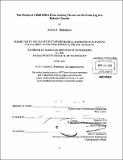| dc.contributor.advisor | Sangbae Kim. | en_US |
| dc.contributor.author | Blakemore, Andrea L. (Andrea Leigh) | en_US |
| dc.contributor.other | Massachusetts Institute of Technology. Dept. of Mechanical Engineering. | en_US |
| dc.date.accessioned | 2012-02-29T18:22:06Z | |
| dc.date.available | 2012-02-29T18:22:06Z | |
| dc.date.copyright | 2011 | en_US |
| dc.date.issued | 2011 | en_US |
| dc.identifier.uri | http://hdl.handle.net/1721.1/69503 | |
| dc.description | Thesis (S.B.)--Massachusetts Institute of Technology, Dept. of Mechanical Engineering, 2011. | en_US |
| dc.description | Cataloged from PDF version of thesis. | en_US |
| dc.description | Includes bibliographical references (p. 37). | en_US |
| dc.description.abstract | To successfully design and program legged robots, it is important to be able to characterize the forces felt on the moving joints. To achieve this, we designed an easy to implement force sensor that used Hall Effect sensors mounted on a flexure to measure force. The flexure was designed to be compliant in two directions, along the ground normal and shear reaction forces. The Hall Effect sensors were mounted so that the change in position of a magnet on the sensor translated to a change in position. By relating this data, the voltage output of the Hall Effect sensors could be related to force through a calibration matrix. The flexure was prototyped at a large scale of 5 in x 5 in x 7 in. The force sensor behaved as expected in compression but abnormally when encountering large shear forces, causing a discrepancy in the calibration matrix. Moving forward, tightening tolerances on the flexure and modifying the Hall Effect sensor setup to use 2- axis sensing for both compression and shear directions should decrease the error between calculated and actual force measurements, allowing for a reliable calibration matrix to be calculated. | en_US |
| dc.description.statementofresponsibility | by Andrea L. Blakemore. | en_US |
| dc.format.extent | 37 p. | en_US |
| dc.language.iso | eng | en_US |
| dc.publisher | Massachusetts Institute of Technology | en_US |
| dc.rights | M.I.T. theses are protected by
copyright. They may be viewed from this source for any purpose, but
reproduction or distribution in any format is prohibited without written
permission. See provided URL for inquiries about permission. | en_US |
| dc.rights.uri | http://dspace.mit.edu/handle/1721.1/7582 | en_US |
| dc.subject | Mechanical Engineering. | en_US |
| dc.title | The design of a Hall Effect force sensing flexure on the front leg of a robotic cheetah | en_US |
| dc.type | Thesis | en_US |
| dc.description.degree | S.B. | en_US |
| dc.contributor.department | Massachusetts Institute of Technology. Department of Mechanical Engineering | |
| dc.identifier.oclc | 775673718 | en_US |
